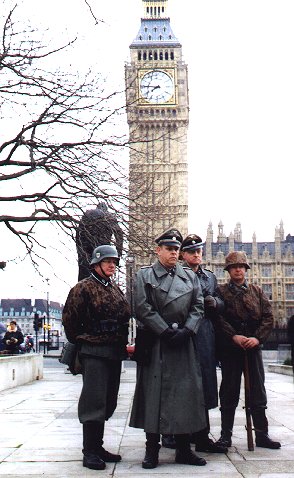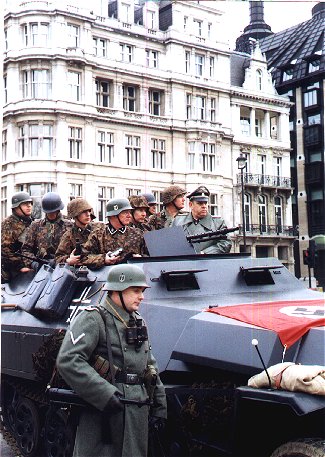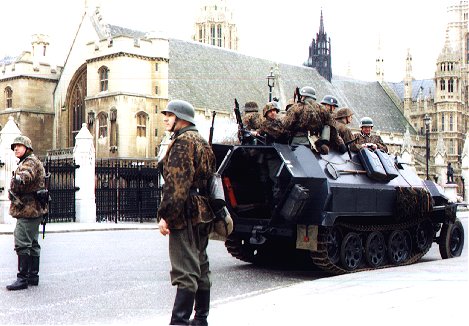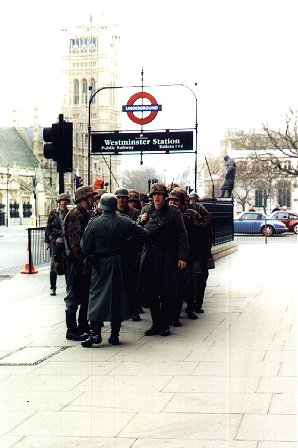Operation Sealion: The SBG’s
Invasion of London.
Filming with the BBC
Sunday February 18th 2001
Reproduced from Signal Nr. 188
 Once
again it was a phenomenal group effort which brought this event to "Life". The
SBG were contacted by the BBC and asked to supply
some vehicles and men for a three part documentary called "Invasion" which was
to be about how England has always feared the
threat of being invaded and overrun throughout history. The third
programme will examine the state of Britain's defences in the 20th century, and
will include a history of 'invasion scares', the advent of air-power and the
first 'high-tech' responses to the aerial threat, coastal and inland defences
against invasion from the sea and key historical events such as the Battle of
Britain and Hitler's Operation Sealion.
Once
again it was a phenomenal group effort which brought this event to "Life". The
SBG were contacted by the BBC and asked to supply
some vehicles and men for a three part documentary called "Invasion" which was
to be about how England has always feared the
threat of being invaded and overrun throughout history. The third
programme will examine the state of Britain's defences in the 20th century, and
will include a history of 'invasion scares', the advent of air-power and the
first 'high-tech' responses to the aerial threat, coastal and inland defences
against invasion from the sea and key historical events such as the Battle of
Britain and Hitler's Operation Sealion.
Operation Sealion was Adolf
Hitlers planned Invasion of England in the early 1940's. Whether or not this was
a genuine invasion plan or a ruse to fool Stalin that the invasion of Russia was
going to take place much later will never be known.
As part of the enactment, the BBC
filmed their presenter Dan Cruickshank introducing the programme in front of our
Half-track before the Houses of Parliament. But as always it was the membership
pulling together which really made this event something special. Many members
contacted me suggesting what should have been worn and used during the early war
period as the SBG basically portrays Grenadiers from the Normandy 1944 period. Unfortunately the event happened so fast we didn’t have time to acquire
type I smocks, M35 helmets and early K98.s for everyone but even so no one could have done
what the SBG did on this day in such a short time span. Interestingly, besides
gas masks cape bags being worn across the chest ( which was obvious but no one
seemed to think of except Schar. Gurowski ) Oscha. Meyer also found out that Y
straps were not commonly worn in combat by the Waffen-SS during the early European
campaigns and Gren. Barkmann found out that type II smocks were issued in the
latter part 1942 and we also found
that entrenching tools and full combat kit was carried during street fighting. I
re-checked a video of the LAH in action during the
Polish, Dutch, French and Greek campaigns which also helped in determining our
look for that period .
 As part of the
enactment, the BBC filmed their presenter Dan Cruickshank introducing the
programme in front of our Half-track before the Houses of Parliament. In various cases some members had to be put at the back
of the group so later war items were not so noticeable.
As part of the
enactment, the BBC filmed their presenter Dan Cruickshank introducing the
programme in front of our Half-track before the Houses of Parliament. In various cases some members had to be put at the back
of the group so later war items were not so noticeable.
The initial criteria considered was for some
50 men, a Pz.Kpfw MkII, a Half track, a truck and a motorcycle but this was
finally reduced to just the Half track and 12 men due to budget. However, it was
decided to involve as many members as possible and 25 active members turned up for the event which
was just as well because this meant the BBC could film in different locations
simultaneously. A feat that could not have been accomplished in the time limit
had we supplied just the 12 men that the BBC had budgeted for.
 It was certainly a hands on job for the Half
track transformation as well. A number of members spent many evenings and
weekends working on the vehicle getting it ready for the filming. These included
Rttf. Haller (Mark Harris) who over a period of weeks repaired the brakes,
clutch and serviced the Half track to ensure that it was in perfect running
order. Strm. Rössler and Gren. Wilcks ( John Redman and Andy Wilkins ) worked
on many of the other tasks including preparation for the final spray and spent a
lot of hours working on the vehicle, Strm. Wörner was also heavily involved and
supervised the colour co-ordination and early war insignia, organised the
vehicles transportation and drove the Half track during the filming. Last but
not least a final group effort was required to finish the Half track and thanks
to Strm. Speidel, Obgren. Liebermann and Stubaf. Jury for a final bout of hard work to finish the vehicle on the
preceding Sunday.
It was certainly a hands on job for the Half
track transformation as well. A number of members spent many evenings and
weekends working on the vehicle getting it ready for the filming. These included
Rttf. Haller (Mark Harris) who over a period of weeks repaired the brakes,
clutch and serviced the Half track to ensure that it was in perfect running
order. Strm. Rössler and Gren. Wilcks ( John Redman and Andy Wilkins ) worked
on many of the other tasks including preparation for the final spray and spent a
lot of hours working on the vehicle, Strm. Wörner was also heavily involved and
supervised the colour co-ordination and early war insignia, organised the
vehicles transportation and drove the Half track during the filming. Last but
not least a final group effort was required to finish the Half track and thanks
to Strm. Speidel, Obgren. Liebermann and Stubaf. Jury for a final bout of hard work to finish the vehicle on the
preceding Sunday.
 We must also not forget our female members who
helped out, Wendy for photocopying the maps, writing and inking in directions
which were then sent out to members and photographing us all day long and also
Rose who video filmed us the whole day. A fantastic
group effort and well done and thank you to all the above members.
We must also not forget our female members who
helped out, Wendy for photocopying the maps, writing and inking in directions
which were then sent out to members and photographing us all day long and also
Rose who video filmed us the whole day. A fantastic
group effort and well done and thank you to all the above members.
And so, the day started with the SBG arriving at 6.30 am and
parking in Whitehall place, alongside the original Scotland Yard Police station
and opposite Horse Guards Parade no less !. As we pulled up in our cars and saw
our trusty Half track parked on the low loader across the road we knew it was
all about to happen, the SBG had finally pulled off Operation Sealion (some 60
years late, but better late then never ).
As requested all members turned up wearing
most of their uniform and within no time at all 25 fully kitted up members were
either on the Half track or marching in front of it down Whitehall. Of course,
this has been done before, notably in the excellent Kevin Brownlow film "
It happened here " ( c.1965 ) and again in c. 1973 for a similar BBC
documentary but, as with " saving private ryan " it was the first time
a Living History Society had been used as extras instead of actors and hired
uniforms.
Page
2
 Once
again it was a phenomenal group effort which brought this event to "Life". The
SBG were contacted by the BBC and asked to supply
some vehicles and men for a three part documentary called "Invasion" which was
to be about how England has always feared the
threat of being invaded and overrun throughout history. The third
programme will examine the state of Britain's defences in the 20th century, and
will include a history of 'invasion scares', the advent of air-power and the
first 'high-tech' responses to the aerial threat, coastal and inland defences
against invasion from the sea and key historical events such as the Battle of
Britain and Hitler's Operation Sealion.
Once
again it was a phenomenal group effort which brought this event to "Life". The
SBG were contacted by the BBC and asked to supply
some vehicles and men for a three part documentary called "Invasion" which was
to be about how England has always feared the
threat of being invaded and overrun throughout history. The third
programme will examine the state of Britain's defences in the 20th century, and
will include a history of 'invasion scares', the advent of air-power and the
first 'high-tech' responses to the aerial threat, coastal and inland defences
against invasion from the sea and key historical events such as the Battle of
Britain and Hitler's Operation Sealion. As part of the
enactment, the BBC filmed their presenter Dan Cruickshank introducing the
programme in front of our Half-track before the Houses of Parliament. In various cases some members had to be put at the back
of the group so later war items were not so noticeable.
As part of the
enactment, the BBC filmed their presenter Dan Cruickshank introducing the
programme in front of our Half-track before the Houses of Parliament. In various cases some members had to be put at the back
of the group so later war items were not so noticeable.  It was certainly a hands on job for the Half
track transformation as well. A number of members spent many evenings and
weekends working on the vehicle getting it ready for the filming. These included
Rttf. Haller (Mark Harris) who over a period of weeks repaired the brakes,
clutch and serviced the Half track to ensure that it was in perfect running
order. Strm. Rössler and Gren. Wilcks ( John Redman and Andy Wilkins ) worked
on many of the other tasks including preparation for the final spray and spent a
lot of hours working on the vehicle, Strm. Wörner was also heavily involved and
supervised the colour co-ordination and early war insignia, organised the
vehicles transportation and drove the Half track during the filming. Last but
not least a final group effort was required to finish the Half track and thanks
to Strm. Speidel, Obgren. Liebermann and Stubaf. Jury for a final bout of hard work to finish the vehicle on the
preceding Sunday.
It was certainly a hands on job for the Half
track transformation as well. A number of members spent many evenings and
weekends working on the vehicle getting it ready for the filming. These included
Rttf. Haller (Mark Harris) who over a period of weeks repaired the brakes,
clutch and serviced the Half track to ensure that it was in perfect running
order. Strm. Rössler and Gren. Wilcks ( John Redman and Andy Wilkins ) worked
on many of the other tasks including preparation for the final spray and spent a
lot of hours working on the vehicle, Strm. Wörner was also heavily involved and
supervised the colour co-ordination and early war insignia, organised the
vehicles transportation and drove the Half track during the filming. Last but
not least a final group effort was required to finish the Half track and thanks
to Strm. Speidel, Obgren. Liebermann and Stubaf. Jury for a final bout of hard work to finish the vehicle on the
preceding Sunday. We must also not forget our female members who
helped out, Wendy for photocopying the maps, writing and inking in directions
which were then sent out to members and photographing us all day long and also
Rose who video filmed us the whole day. A fantastic
group effort and well done and thank you to all the above members.
We must also not forget our female members who
helped out, Wendy for photocopying the maps, writing and inking in directions
which were then sent out to members and photographing us all day long and also
Rose who video filmed us the whole day. A fantastic
group effort and well done and thank you to all the above members.